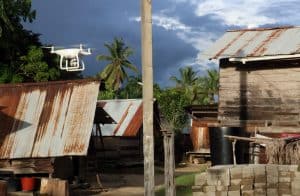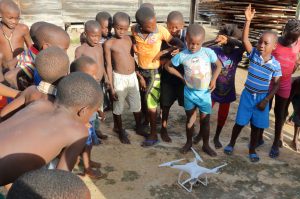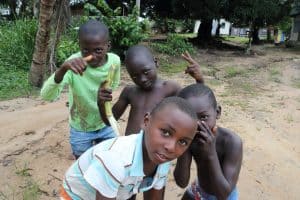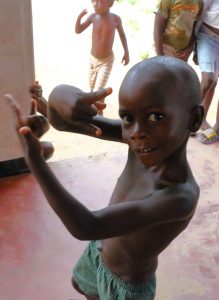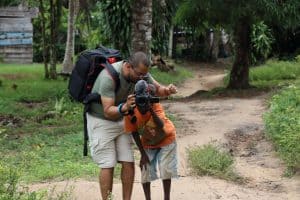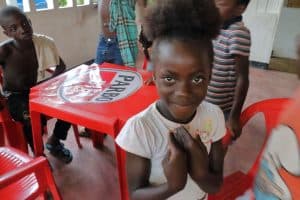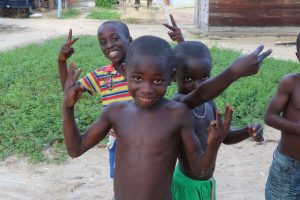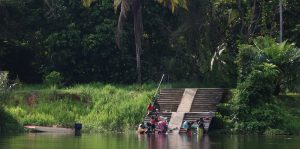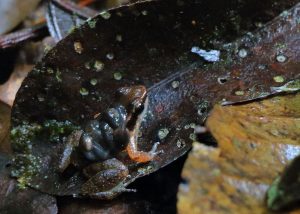Suriname has rather a lot of jungle. In fact, it’s pretty much all they’ve got here. Best we take a peek then. Last blog we had the thrill of a live rocket launch in French Guiana, now we see the jungle kids’ thrill of seeing their first drone! We’re heading far in-land, well beyond where Cuthbert our camp-truck can take us. Here’s the story in our Suriname jungle blog …

Winching and Falls
 The road ends some 200km inland from Paramaribo at the tiny village of Pokigron, but on the way we do a de-tour for a couple of days into the Brownsberg Reserve. Here we plan to do some short hikes to waterfalls, but we hadn’t banked on having to winch a huge fallen tree out of the track to get to the trail! Overlanders often question the necessity of fitting a winch to their vehicle… well, we’ve found ours handy not only for vehicle recovery.
The road ends some 200km inland from Paramaribo at the tiny village of Pokigron, but on the way we do a de-tour for a couple of days into the Brownsberg Reserve. Here we plan to do some short hikes to waterfalls, but we hadn’t banked on having to winch a huge fallen tree out of the track to get to the trail! Overlanders often question the necessity of fitting a winch to their vehicle… well, we’ve found ours handy not only for vehicle recovery.
 Anyway… when we get to Pokigron we join-up with Erick, a friendly Costa Rican traveller who we’ve happily been bumping into a lot over the last few weeks. Pokigron is teeny, a real ‘one horse town’, but it’s a bustling little place. From here, many dug-out long-boats ply up and down to the riverside settlements and we’ll need to seek-out one of these to get further into the jungle. The nice surprise when we arrive is that Erick has already done the hard work and secured a boatman to take us all up-stream. What a nice chap!
Anyway… when we get to Pokigron we join-up with Erick, a friendly Costa Rican traveller who we’ve happily been bumping into a lot over the last few weeks. Pokigron is teeny, a real ‘one horse town’, but it’s a bustling little place. From here, many dug-out long-boats ply up and down to the riverside settlements and we’ll need to seek-out one of these to get further into the jungle. The nice surprise when we arrive is that Erick has already done the hard work and secured a boatman to take us all up-stream. What a nice chap!
Heading deep into the rainforest (as you do!) one might be forgiven for expecting to find settlements populated by native Amerindians. But the guys here have a very different heritage. They’re known as Maroons, and they’re African. How so?
African Heritage
 Well… around 300 years ago, a brave band of slaves rightly took umbrage at their unimaginably despicable conditions and escaped into the jungle. They moved east until they came to the river, which seemed a good place to stop. South America was a new continent for them, but ‘jungle survival’ is what today’s business gurus might term a ‘transferrable skill’. The slaves chummed-up with the native Amerindians, learned about the particular nature of the Amazon, and here they are today… small but thriving Maroon communities dotted all along the banks of the Suriname River. Don’t say we don’t teach you a bit of culture and history here folks 🙂
Well… around 300 years ago, a brave band of slaves rightly took umbrage at their unimaginably despicable conditions and escaped into the jungle. They moved east until they came to the river, which seemed a good place to stop. South America was a new continent for them, but ‘jungle survival’ is what today’s business gurus might term a ‘transferrable skill’. The slaves chummed-up with the native Amerindians, learned about the particular nature of the Amazon, and here they are today… small but thriving Maroon communities dotted all along the banks of the Suriname River. Don’t say we don’t teach you a bit of culture and history here folks 🙂
Numbers now visiting the area are still very small, but the Maroons are understandably keen to capitalise on an increasing curiosity about their lifestyle. A handful of Maroons are now making a living as guides/cooks, and cabins are popping up along the river to host tourists. We’re spending four days at one called Menimi, spending time on jungle walks and visits to the local villages with a guide.

Subsistence living – pounding the rice
So what is the Maroon lifestyle? Well… to start with, it’s subsistence-living. Although they have frequent boat connectivity with the ‘real world’, very little is brought in from outside. They grow all their own vegetables, pound their own rice, hunt their own meat. There are no shops and almost no trade amongst them, although we did spot one barbers and one bar (who doesn’t like to look good when they pop out for a beer, eh? ).
Inevitably we find ourselves comparing the Maroon communities to similar places we visited in Africa. The big contrast is that in the African villages, with the rare exception of the Himba village in northern Namibia, we found packaged commercialism to be well established. The imported supplies bring associated packaging: tins, plastic bottles and bags. Of course, the suppliers bring with them no means of, or education regarding, waste disposal. Consequently, the communities suffer badly from street litter and large festering mounds of refuse. Attempts at burning the piles of waste-plastics serve only to bathe the villages in dense clouds of black, toxic-looking smoke, which small children inhale as they play around the fires. The Maroons of Suriname suffer from none of this. They live free of litter and enjoy a diet of locally sourced produce – some of it cultivated and some naturally occurring in the jungle – with minimal waste.
21st Century Droning

Every little boy was a little poser! The girls not so much!
So it’s an eco-friendly place. So far so good. But another admirable thing about the Maroon subsistence lifestyle is that it doesn’t prevent them from moving into the 21st Century in other ways. They have solar-power (topped-up by generators when necessary). Cell-masts are installed periodically down the river and they have 3G connectivity. Although they can’t all afford smart-phones, the children are all familiar with these. Posing enthusiastically for photos, they eagerly want to know whether they will be famous on the ‘eeen-terrr-nehhht’ 🙂
Despite all the connectivity however, they’re really not prepared for the next 21st Century gadget we are about to unleash upon them. Maroon people of Suriname… we present to you… THE DRONE!!!

We are travelling with a first-generation DJI Phantom drone which we love and use when conditions permit. But Erick has invested in one of the latest ‘all-singing-dancing’ models. It has super-easy touch-screen controls and a real-time feed from the camera down to the controlling iPad screen. Our guide isn’t sure what the villagers will make of this and first seeks permission from the village elder. His explanation that Erick has brought a flying machine to take pictures from the air is met with looks of humorous disbelief, but a small contribution to local funds gains permission to fly the drone in the village.
Word of a ‘flying machine’ spreads quickly around the houses. In the two minutes that it takes Erick to un-pack the whirly-bird from its case, a curious crowd gathers around him. As the drone buzzes, beeps and takes to the sky, the villagers gasp upwards in awe. The drone disappears from view and they jostle around Erick to see the live-feed pictures on his screen. They’ve obviously never seen their village from the air before. After a few minutes they seem to be wondering whether the flying machine will be coming back. There is a rabble cheer from the children when it finally comes back into view.

Erick brings the drone down and hovers it a meter or so out of reach above the tallest children. They leap around excitedly, shouting, jostling each other, jumping up trying to grasp the under-carriage. When they realise that they’re being filmed from above, they start dancing and posing in front of the tiny, suspended camera. The whole event is a marvellous scene. It’s a real privilege to witness a new step in these people’s awareness of our world. Scroll to the bottom of this post to see the video of the excited kids!
So, after four days with the Maroons we’ve learned much about their way of life, their culture and beliefs, their foods. Oh, and their boat-building too! It’s been fascinating. Our boatman takes us back home to Cuthbert. Now the task of sorting the many (many) photos and writing up the Suriname jungle blog.
One teeeny detail that we hadn’t realised when we left Cuthbert in Pokigron is quite how soft the ground is around there! We return to find Cuthbert sitting at a rather unusual angle. The locals, having witnessed the gradually decline were fearing for the worst and thought we might be stuck! Time for the winch again? Noooo… it’s amazing what low-range gears and a few diff-locks can do! Cuthbert is straight out… no problem… off to the next adventure.
Link to next blog: So… Suriname! Link to full South America Blog
Suriname Jungle Blog Gallery
- Subsistence living – pounding the rice


